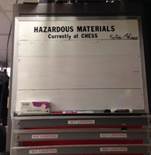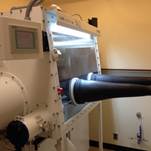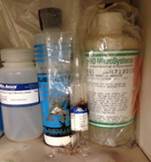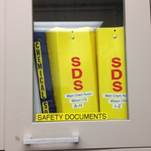You are here: CLASSE Wiki>CHESS Web>Ref-saf-004 (21 Apr 2017, ljs30)Edit Attach
| Cornell High Energy Synchrotron Source | ||||
| Doc#: REF-SAF-004 | Procedure: CHESS Safety Committee Update (1/7/15) | Prepared by: AK | ||
| Rev.: 1 | Revision Date: 01/07/15 |
Date Effective: 01/20/15 |
Date Expires: 01/20/16 | Approved by: DR |
Hello! In effort to prevent some of the safety concerns that occurred during the past run, we have put together this update to help communicate old and new safety information. This update includes reminders on how the CHESS Safety Committee functions, a summary of the glove box rules, safe chemical segregation, and a list of new or recently updated CHESS SOPÂs.
 Reminders
Reminders* The CHESS Safety Committee has to approve all proposals, projects, and beamtime requests prior to the arrival of the user(s) and/or their materials at CHESS. All equipment, materials, and chemicals must be declared. All requests for more information (e.g. SDSÂs, SOPÂs, diagrams, equipment specs) must be satisfied. The CHESS Safety Committee reserves the right to prohibit a user groupÂs activities if requests for information are not satisfied or if the information submitted is inaccurate.
* If a user or Beamline Scientist would like to make any modifications to an already approved proposal, project, or beamtime request the CHESS Safety Committee must be notified. Beamline Scientists should update the User Database as research plans develop and also notify the CHESS Safety Committee of these changes (e.g. requests to use the glove box, additional chemicals or equipment to be brought to CHESS). Once the run starts last minute changes are difficult to accommodate and should be avoided.
* Shipments of equipment and research materials to and from CHESS should go through the CHESS User Program Office to ensure that proper DOT shipping requirements are satisfied. Any chemicals and/or other hazardous materials that are received by other means should be immediately presented to the CHESS Safety Committee.
* The sooner that research groups are scheduled on the user database, the easier it is for the CHESS Safety Committee to reserve other lab resources and coordinate research spaces between all the users (e.g. fume hoods, bench space, glove box, or other specialized equipment).
 Glove box rules
Glove box rulesTo help keep the glove box in good working condition and to prevent the improper storage of chemicals inside it, the glove box room door will be kept locked. The CHESS Operator will unlock the door for users and staff as needed. Before using the CHESS glove box you must:
- Complete glove box training provided by CHESS staff.
- Submit an SOP to the CHESS Safety Committee containing details about the work you will be doing (include the SDSÂs for any chemicals and/or materials).
- Receive approval from the CHESS Safety Committee.
- Request access into the glove box room (RM 172) from the CHESS Operator.
- Keep the glove box room door open during all work.
- Wear safety glasses inside the glove box room at all times.
- Remove all hand and wrist jewelry (e.g. rings, bracelets, and watches).
- Wear nitrile gloves over the butyl box gloves (inside the glove box) in order to protect the butyl gloves from chemicals.
- Wear additional protection over the butyl box gloves if you are working with sharp instruments (e.g. needles, razor blades, and scissors).
- Have preapproval from the CHESS Safety Committee to transfer your items into the glove box.
- Post the SDSÂs for any chemicals and/or materials transferred into the glove box.
 Chemical Segregation
Chemical SegregationThe Main Chem Room has been reorganized using the EH&S recommended DOT Hazard Class Scheme. This scheme uses information that is easily found from SDSÂs, container labels, and other resources. Note that chemicals do not always fall neatly into one hazard class and can pose multiple hazards (e.g. acetic acid is both corrosive and flammable).The chart below is intended to help organize chemicals that are permanently stored in the Main Chem Room. The Hazard classes that are highlighted Âred are currently present.
| Guide to Chemical Segregation in Wilson 170 (the Main Chemical Room) | ||
| DOT Number | Hazard Class | Storage Location |
| Class 1 | Explosives | N/A |
| Class 2 |
Compressed gases 2.1 Â Flammable gases 2.2 Â Non-flammable gases 2.3 Â Poisonous gases | N/A |
| Class 3 | Flammable liquids | Underneath the fume hood, in the ÂFlammables cabinet. |
| Class 4 |
Flammable solids 4.1  Flammable solids 4.2  Spontaneously combustible 4.3  Dangerous when wet | Underneath the fume hood, in the ÂFlammables cabinet, in a designated secondary container. |
| Class 5 |
Oxidizers 5.1  Oxidizers 5.2  Organic peroxides | In the ÂChemicals cabinet, in a designated secondary container. |
| Class 6 |
Poisons 6.1 Â Poisons 6.2 Â Biohazards |
In the ÂChemicals cabinet, on the designated shelf space. *Note that poisons that are additionally flammable will be stored with Class 3 hazards. |
| Class 7 | Radioactive materials | N/A |
| Class 8 | Corrosives |
Acids are stored in the ÂAcids cabinet, with the exception of flammable organic acids (i.e. acetic acid). Bases are stored in the ÂChemicals cabinet. Note that some acids/bases are not corrosive enough to be rated as a DOT Class 8 hazard, and will be stored with Class 6 hazards. |
| *Class 9 | Miscellaneous | Are stored with Class 6 hazards for segregation purposes. |
 New and updated SOPÂs
New and updated SOPÂsOver the past year efforts have been made by the CHESS Safety Committee to update existing SOPÂs and to also create SOPÂs for any homebuilt equipment being used throughout lab. CHESS staff should submit SOPÂs for any new equipment as they are being developed.
There are two types of CHESS SOPÂs. The first type is mainly intended for internal training purposes (i.e. CHESS staff and approved users). SOPÂs in this category can be found in the CHESS Document Index ( https://docs.google.com/spreadsheet/lv?key=0At6t-UCtlBPpdGoxTWdFZk1Kdy14TTNMdUN2QmFNT0E). The second type is intended to communicate, to all individuals at CHESS, the potential hazards of a piece of equipment and any safety precautions that need to be taken when the equipment is being used. SOPÂs in this category will be attached to relevant proposals, projects, and beamtime requests on the User Database, posted in the Hazardous Materials Binder when in use, and can be obtained from the CHESS Safety Committee at any time.
Internal Chemical Safety SOPÂs:
- SOP-CHEM-001 Hydrofluoric Acid Use
- SOP-CHEM-002 Nitric Acid Use
Updated (Changes in permitted use time, required PPE, and waste disposal. New figures added.) - SOP-CHEM-003 Silicon Etching
Updated (Edits to reflect changes in Hydrofluoric and Nitric Acid SOPÂs.)
- SOP-CHEM-004 Hazardous Waste Disposal
- SOP-CHEM-005 Peroxide-Forming Chemicals
- SOP-CHEM-006 Acid & Base Neutralization
Coming soon! - SOP-CHEM-007 Solvent Use at CHESS Experimental Stations
- SOP-CHEM-008 Nanoparticle Use
Coming soon!
Lab Equipment Communication SOPÂs:
- D1 closed GISAXS heating stage
- D1 grazing incidence heating stage
New!
- D1 knife coater
New!
- D1 spin coater
- D1 transmission heating stage
New!
Edit | Attach | Print version | History: r1 | Backlinks | View wiki text | Edit wiki text | More topic actions
Topic revision: r1 - 21 Apr 2017, ljs30
 Copyright © by the contributing authors. All material on this collaboration platform is the property of the contributing authors.
Copyright © by the contributing authors. All material on this collaboration platform is the property of the contributing authors. Ideas, requests, problems regarding CLASSE Wiki? Send feedback
